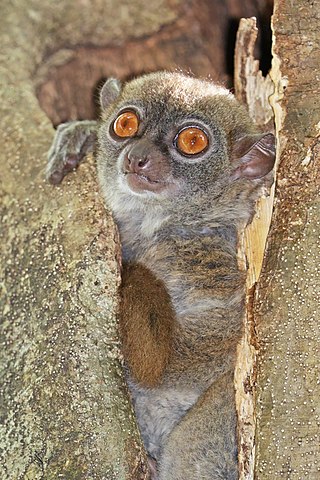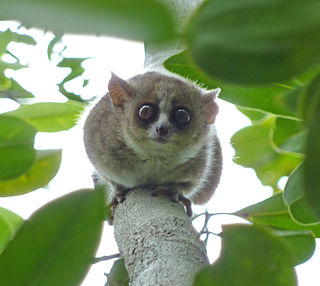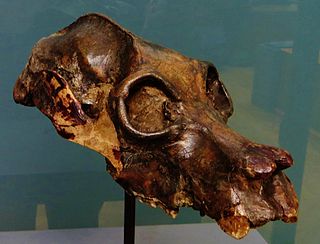
The sportive lemurs are the medium-sized primates that make up the family Lepilemuridae. The family consists of only one extant genus, Lepilemur. They are closely related to the other lemurs and exclusively live on the island of Madagascar. For a time, this family was named Megaladapidae, but the current name was given precedence since the extinct genus Megaladapis was removed from the family.

Lemurs are wet-nosed primates of the superfamily Lemuroidea, divided into 8 families and consisting of 15 genera and around 100 existing species. They are endemic to the island of Madagascar. Most existing lemurs are small, have a pointed snout, large eyes, and a long tail. They chiefly live in trees and are active at night.

Archaeoindris fontoynontii is an extinct giant lemur and the largest primate known to have evolved on Madagascar, comparable in size to a male gorilla. It belonged to a family of extinct lemurs known as "sloth lemurs" (Palaeopropithecidae) and, because of its extremely large size, it has been compared to the ground sloths that once roamed North and South America. It was most closely related to Palaeopropithecus, the second largest type of sloth lemur. Along with the other sloth lemurs, Archaeoindris was related to the living indri, sifakas, and woolly lemurs, as well as the recently extinct monkey lemurs (Archaeolemuridae). The genus, Archaeoindris, translates to "ancient indri-like lemur", even though it probably became extinct recently, around 350 BCE.

Palaeopropithecus is a recently extinct genus of large sloth lemurs from Madagascar related to living lemur species found there today. Three species are known, Palaeopropithecus ingens, P. maximus, and P. kelyus. Radiocarbon dates indicate that they may have survived until around 1300–1620 CE. Malagasy legends of the tretretretre or tratratratra are thought to refer to P. ingens.

The monkey lemurs or baboon lemurs (Archaeolemuridae) are a recently extinct family of lemurs known from skeletal remains from sites on Madagascar dated to 1000 to 3000 years ago.

The sloth lemurs (Palaeopropithecidae) comprise an extinct family of lemurs that includes four genera. The common name can be misleading, as members of Palaeopropithecidae were not closely related to sloths. This clade has been dubbed the ‘‘sloth lemurs’’ because of remarkable postcranial convergences with South American sloths. Despite postcranial similarities, the hands and feet show significant differences. Sloths possess long, curved claws, while sloth lemurs have short, flat nails on their distal phalanges like most primates.

Archaeolemur is an extinct genus of subfossil lemurs known from the Holocene epoch of Madagascar. Archaeolemur is one of the most common and well-known of the extinct giant lemurs as hundreds of its bones have been discovered in fossil deposits across the island. It was larger than any extant lemur, with a body mass of approximately 18.2–26.5 kg (40–58 lb), and is commonly reconstructed as the most frugivorous and terrestrial of the fossil Malagasy primates. Colloquially known as a "monkey lemur," Archaeolemur has often been compared with anthropoids, specifically the cercopithecines, due to various morphological convergences. In fact, it was even misidentified as a monkey when remains were first discovered. Following human arrival to Madagascar just over 2000 years ago, many of the island’s megafauna went extinct, including the giant lemurs. Radiocarbon dating indicates that Archaeolemur survived on Madagascar until at least 1040-1290 AD, outliving most other subfossil lemurs.

Pachylemur is an extinct, giant lemur most closely related to the ruffed lemurs of genus Varecia. Two species are known, Pachylemur insignis and Pachylemur jullyi, although there is some doubt as to whether or not they may actually be the same species. Pachylemur is sometimes referred to as the giant ruffed lemur, because although it and the living ruffed lemurs had similar teeth and skeletons, Pachylemur was more robust and as much as three to four times larger. DNA studies have confirmed a sister group relationship between these two types of lemur. Like living ruffed lemurs, Pachylemur specialized in eating fruit, and was therefore an important seed disperser, possibly for tree species with seeds too large for even ruffed lemurs to swallow. In the spiny thickets of southwestern Madagascar, they were also likely to have dispersed seeds evolved to attach to fur and be carried away. Unlike ruffed lemurs, the fore- and hindlimbs of Pachylemur were nearly the same length, and therefore it was likely to be a slow, deliberate climber. However, both used hindlimb suspension to reach fruit on small branches below them.

Hadropithecus is a medium-sized, extinct genus of lemur, or strepsirrhine primate, from Madagascar that includes a single species, Hadropithecus stenognathus. Due to its rarity and lack of sufficient skeletal remains, it is one of the least understood of the extinct lemurs. Both it and Archaeolemur are collectively known as "monkey lemurs" or "baboon lemurs" due to body plans and dentition that suggest a terrestrial lifestyle and a diet similar to that of modern baboons. Hadropithecus had extended molars and a short, powerful jaw, suggesting that it was both a grazer and a seed predator.

Babakotia is an extinct genus of medium-sized lemur, or strepsirrhine primate, from Madagascar that contains a single species, Babakotia radofilai. Together with Palaeopropithecus, Archaeoindris, and Mesopropithecus, it forms the family Palaeopropithecidae, commonly known as the sloth lemurs. The name Babakotia comes from the Malagasy name for the indri, babakoto, to which it and all other sloth lemurs are closely related. Due to its mix of morphological traits that show intermediate stages between the slow-moving smaller sloth lemurs and the suspensory large sloth lemurs, it has helped determine the relationship between both groups and the closely related and extinct monkey lemurs.

Mesopropithecus is an extinct genus of small to medium-sized lemur, or strepsirrhine primate, from Madagascar that includes three species, M. dolichobrachion, M. globiceps, and M. pithecoides. Together with Palaeopropithecus, Archaeoindris, and Babakotia, it is part of the sloth lemur family (Palaeopropithecidae). Once thought to be an indriid because its skull is similar to that of living sifakas, a recently discovered postcranial skeleton shows Mesopropithecus had longer forelimbs than hindlimbs—a distinctive trait shared by sloth lemurs but not by indriids. However, as it had the shortest forelimbs of all sloth lemurs, it is thought that Mesopropithecus was more quadrupedal and did not use suspension as much as the other sloth lemurs.

Lemurs, primates belonging to the suborder Strepsirrhini which branched off from other primates less than 63 million years ago, evolved on the island of Madagascar, for at least 40 million years. They share some traits with the most basal primates, and thus are often confused as being ancestral to modern monkeys, apes, and humans. Instead, they merely resemble ancestral primates.

Subfossil lemurs are lemurs from Madagascar that are represented by recent (subfossil) remains dating from nearly 26,000 years ago to approximately 560 years ago. They include both extant and extinct species, although the term more frequently refers to the extinct giant lemurs. The diversity of subfossil lemur communities was greater than that of present-day lemur communities, ranging to as high as 20 or more species per location, compared with 10 to 12 species today. Extinct species are estimated to have ranged in size from slightly over 10 kg (22 lb) to roughly 160 kg (350 lb). Even the subfossil remains of living species are larger and more robust than the skeletal remains of modern specimens. The subfossil sites found around most of the island demonstrate that most giant lemurs had wide distributions and that ranges of living species have contracted significantly since the arrival of humans.

Lemurs were first classified in 1758 by Carl Linnaeus, and the taxonomy remains controversial today, with approximately 70 to 100 species and subspecies recognized, depending on how the term "species" is defined. Having undergone their own independent evolution on Madagascar, lemurs have diversified to fill many ecological niches normally filled by other types of mammals. They include the smallest primates in the world, and once included some of the largest. Since the arrival of humans approximately 2,000 years ago, lemurs have become restricted to 10% of the island, or approximately 60,000 square kilometers (23,000 sq mi), and many face extinction. Concerns over lemur conservation have affected lemur taxonomy, since distinct species receive increased conservation attention compared to subspecies.
Plesiopithecus is an extinct genus of early strepsirrhine primate from the late Eocene.

Berthe Rakotosamimanana was a primatologist and palaeontologist from Madagascar.
Ampasambazimba is a mountain peak and subfossil site in Madagascar, near Analavory, (Itasy) most known for being the site of the remains of the extinct giant sloth lemur Archaeoindris.



















